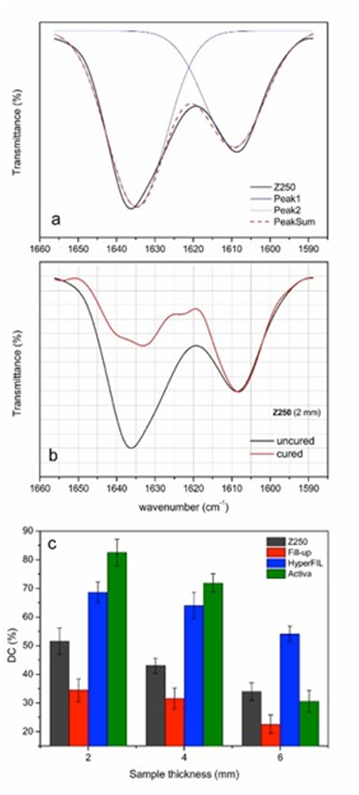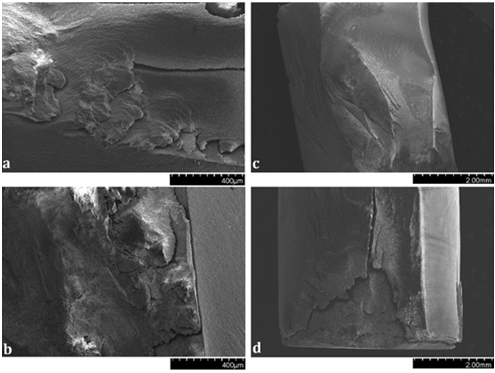Introduction
Resin-based composites (RBCs) can be applied in increments of up to 2mm due to technical concerns about depth of cure (1), volume shrinkage (2), and stress created during curing reactions (3). Some manufacturers have developed flowable or high-viscosity bulk-fill composite materials to address these concerns and related physical issues (4). Moreover, bulk-fill composites can yield an increase in curing depth (5,6) compared to conventional RBCs. It has been suggested that bulk-fill composites can be applied at a thickness of 4mm or more without losing the physical properties or compromising the quality of the restored teeth (7). In addition, the shorter operation times associated with bulk-fill RBCs are regarded as a positive factor in the selection of products for clinical use (8). However, it has been reported that light-cured bulk-fill RBCs possess insufficient polymerization for thicker applications, which can significantly affect the clinical success of restorations due to increased cytotoxicity (9), decreased hardness (10), and sensitivity to marginal defects (11).
RBCs used in dental restoration harden during the polymerization process. This involves many small molecules (monomers) combining to form macromolecules via a series of chemical reactions; in short, it is the conversion of monomers into polymers (12). A key parameter used to quantify polymerization reactions is the degree of conversion (DC), which corresponds to the conversion ratio of carbon-carbon double bonds (C=C) to carbon-carbon single bonds (C-C) to form the polymeric network (13). This chemical reaction is known as crosslinking and is theoretically characterized by the formation of a rigid structure with infinite molecular weight and viscosity. A high DC value is an essential structural feature for improving the mechanical properties, chemical stability, and durability of dental restorations (14,15). Incomplete monomer conversion not only leads to premature damage to restorations and secondary caries (16), but also to monomer elution, which is considered the cause of undesirable biological reactions, such as cytotoxicity and inflammation of the pulp tissue (17). In addition, residual monomers in the composite structure may change the color of the composite and deteriorate its long-term structural properties via oxidation (18,19).
As paste-paste fluid materials, dual-cure bulk-fill resin composites have recently been presented (20) with the objective of decreasing the light attenuation effects by using chemical activation (21). While light irradiation enables rapid initiation of polymerization on the surface and to a certain depth and stabilizes restorations, polymerization proceeds at a much slower rate deeper in the composite due to insufficient light penetration (21). To the best of our knowledge, to date, few studies have examined the polymerization characteristics and mechanical properties of these dual-cure bulk-fill RBCs. In addition, it is essential to investigate how composite thick-ness affects mechanical parameters such as compression strength (CS) and Vickers hardness (VHN). According to several studies (1,2,3,5,10,15), these properties may be connected to the DC of the material and, as a result, may be diminished at the deeper levels of an increment. Moreover, the properties of dual-cured restorative materials should be compared to those of light-cured materials to establish whether their performance is sufficient and appropriate for clinical use.
Therefore, the aim of this study was to evaluate the DC, CS, and bottom/top VHN values of three new dual-cure bulk-fill RBCs and compare them to a conventional light-cure RBC at various application depths: 2,4, and 6mm. The following null hypotheses were tested: 1) regardless of the material, the DC does not significantly decrease as the increment thickness increases, 2) the bottom/top VHN ratio of the tested materials does not significantly decrease as the increment thickness increases, and 3) the CS of the tested materials does differ significantly as the thickness increases.
Materials and methods
Sample size calculation
The power of the sample size (n=180) was calculated using G*Power software (version 3.1, Heinrich-Heine Dusseldorf University, Dusseldorf, Germany) with a 95% confidence interval, 80% power, and 0.50 effect size values according to one-way analysis of variance (ANOVA)-type power analysis. The minimum sample size was calculated to be 15 specimens per group.
Composite materials
In this study, four commercially available dental restorative materials were evaluated. A conventional RBC was used as the control material (Filtek Z250, 3M ESPE, St. Paul, MN). The following three dual-cure bulk-fill composite materials were used as the test materials: a flowable dual-cure bulk-fill composite (Fill-Up, Coltène/Whaledent AG, Altstätten, Switzerland), a bioactive flowable dual-cure bulk-fill composite (ACTIVA BioActive Restorative, Pulpdent Corp., Watertown, MA), and a low-viscosity dual-cure bulk-fill composite (HyperFIL HAp, Parkell Inc., New York, USA). The chemical compositions and lot numbers of the composites, as well as the particle sizes of their inorganic components, are shown in Table 1, and the information is based on the data sheets provided by the manufacturers.
Table 1 Commercial and compositional properties of composites used in this study.
| Composite (manufacturer-LOT number) | Light exposure time | Classification | Resin | Filler content | Particle size | Irradiant energy (J/cm²) |
|---|---|---|---|---|---|---|
| HyperFIL HAp (Parkell Inc., USA) (1901019010) | 40s | Dual-cure bulk-fill composite | BisEMA, HEMA, TEGDMA, BPO, UDMA, and other dimetha-crylate monomers, nano hydroxyapatite | Barium glass/silica 70-75 wt% | 15nm-3.5μm | 44 |
| ACTIVA BioACTIVE- RESTORATIVE (Pulpdent Corp, Watertown, USA) (190110) | 20s | Dual-cure bulk-fill composite | Powder: silanated bioactive glass and calcium, silanated silica, and sodium fluoride Liquid: DUDMA and other methacrylate monomers, MPAA, and water | 55.4 wt% Silica, bioactive glass and sodium fluoride fillers | Submicron to 4 microns | 22 |
| Fill-Up (Coltene, Whale- dent, Switzerland) (1605000141) | 10s | Dual-cure bulk-fill composite | TMPTMA, UDMA, BisGMA, TEGDMA, dental glass, amorphous silica, zinc oxide | Barium aluminofluoride borosilicate glass wt% vol%: 65/49 | 0.1-5μm | 11 |
| Filtek Z250 (3M Espe, St. Paul, MN, USA) (N993561) | 20s | Light-cure microhybrid composite | BisGMA, UDMA, and BisEMA resin | Zirconia/silica particles 82 wt% | 0.01-3.5μm | 22 |
*BisEMA: bisphenol A ethoxy dimethacrylate; BisGMA: bisphenol A glycidyl methacrylate; BPO: dibenzoyl peroxide; DUDMA: Diurethane dimethacrylate; HEMA: 2-hydroxyethyl methacrylate; MPAA: Modified polyacrylic acid; TEGDMA: triethylene glycol dimethacrylate; TMDPO: (2,4,6-trimethylbenzoyl) diphenylphosphinoxide; TMPTA: trimethylolpropane triacrylate; TMPTMA: trimethylol propane trimethacrylate; UDMA: urethane dimethacrylate.
Sample preparation
Samples with a diameter of 5mm and thick- nesses of 2,4, and 6mm were prepared in Teflon molds to determine the DC and to measure the VHN. To prevent oxygen inhibition, transparent polyester tape was placed on the top and bottom of each mold. The resins were applied and irradiated with a light-curing unit (VALO Cordless, Ultradent, South Jordan, UT) according to the manufacturer's instructions in a dark room. The light-emitting end of the curing device gently contacted the polyester strip's surface. All light-curing procedures were performed using the same curing device, which worked in a continuous mode and generated 1,100 mW/cm² of irradiance. It was kept at full charge prior to use, and its irradiance was regularly checked using a dental radiometer (Bluephase Meter II, Ivoclar Vivadent, Schaan, Principality of Liechtenstein). All samples were stored in distilled water at 37°C for 24h prior to testing.
Determination of defree of conversion (DC)
The DC (n=5/group) was measured using Fourier-transform infrared spectroscopy (FTIR) with 16 scans and a resolution of 4 cm-¹ utilizing the attenuated total reflectance method (Alpha; Bruker Optics, Ettlingen, Germany). The DC values were determined at 2,4, and 6mm to represent the bottom of deep cavities. FTIR analyses were quickly performed before and after the photo- induced polymerization (curing) procedure, and the DC values were calculated by following the two characteristic peaks at 1,637 cm-¹ (aliphatic bonds) and 1,608 cm-¹ (aromatic bonds). As the majority of the monomers that comprise the organic phase of dental composites are dimethacrylates, an absorption band at 1,635-1,640 cm-¹, corresponding to C=C double bonds in the methacrylate groups, was used for the quantitative assessment of unreacted methacrylate groups. Peak intensities were compared to an internal reference, the C-C aromatic absorption band at 1,608-1,610 cm-¹, which was not involved in polymerization.
The following equation was used to calculate the ratio of the double-bond content of monomer to polymer in each composite: DC%=(1-(A1637/a1608) polumerized/(A1637/A1608) unpolymerized)x100 where DC is the ratio of aromatic and aliphatic C=C bonds at the peak intensities of 1,637 cm-¹ and 1,608 cm-¹ in polymerized and unpolymerized dual-cure bulk-fill composite samples, respectively.
Vickers hardness (VHN) measurement
The VHN test was conducted with a microhardness tester (HMV M-1, Shimadzu Corp., Kyoto, Japan) with a constant load of 100 g for 15s of dwell time. Prior to testing, all samples were polished with 400-, 800-, 1,000-, 1,500-, 2,000-, and 2,500-grit silicon carbide papers. Then, five indentations were made on the top and bottom surfaces of each sample (2,4, and 6mm) (n=10/group): one in the center and one in each quadrant (>100µm apart). The results were averaged independently and reported as VHN values. To compare the VHN values between the groups, bottom/top ratios of 80% criteria were used for each group to assess microhardness, as suggested in the literature (1).
Compression test
The mechanical properties of the composite samples were tested using a universal tension- compression test machine (WDW20, JINAN Testing Equipment IE Corporation) in compression mode using cylindrical test specimens of 5mm diameter and 2-, 4-, and 6-mm thicknesses based on the ISO/DIN 4049:2009 standard with a crosshead or compression speed of 0.2mm/min. Five samples from each group were tested in the compression test, and the mean values and standard deviations are presented. The mechanical parameters of the samples were determined from typical stress-strain curves obtained from the compression tests.
Fracture surface analysis by scanning electron microscopy (SEM)
The fracture surfaces of representative samples (n=2/group) were examined using scanning electron microcopy (SEM) (Hitachi SU3500 T2, Hitachi Corp., Tokyo, Japan). The size, geometry, and distribution of the inorganic particles in the organic matrix were observed. Prior to SEM analy- sis, all samples were coated with a 10nm thin gold film under vacuum using the SC7620 Mini Sputter Coater (Quorum, East Sussex, UK) to make the samples conductive. After the compression test, the cracked surfaces of the samples were photographed directly using the high-pressure method at 20kV and a working distance of 10mm at 1,500× and 5,000× magnifications.
Statiscal analysis
The bottom/top VHN data were analyzed for homogeneity and normality using the Shapiro-Wilk test and subjected to two-way ANOVA using the General Linear Model procedure for interaction of the factors ''Material'' and ''Specimen depth'' at p=0.05. Post hoc testing for significant interactions was performed using simple effect analysis with Bonferroni adjustment. For CS, each material was individually analyzed for homogeneity and normality (Shapiro-Wilk test) and subjected to one-way ANOVA (factor: depth). Tukey's post hoc test was used to detect significant differences between group mean values (pre-set α=0.05).
Results
DC
Figure 1.a and Figure 1.b show the FTIR spectra of the uncured composites in the wavenumber range of 1,550-1,775 cm-¹ and the C=C double-bond region (1,590-1,660 cm-¹), respec- tively. Figure 2.a shows the peaks of aliphatic and aromatic C=C bonds in an uncured representative sample (Filtek Z250). The FTIR transmittance spectrum of samples was deconvoluted into two peaks by a Lorentzian function after performing a linear baseline correction in a wavenumber range of 1,590-1,660 cm-¹. Areas of 1,608 cm-¹ and 1,637 cm-¹ peaks were determined with the peak deconvolution operation using OriginPro 8.0 software. A change in peak intensity at 1,637 cm-¹ due to crosslinking is illustrated in Figure 2.b. Figure 2.c compares the calculated DC% values of the samples as a function of sample thickness. It was found that the DC% values decreased in the order of ACTIVA>HyperFIL>Filtek Z250>Fill-Up for sample thicknesses of 2mm and 4mm. For the 6 mm-thick samples, this order was HyperFIL>Filtek Z250≥ACTIVA>Fill-Up.
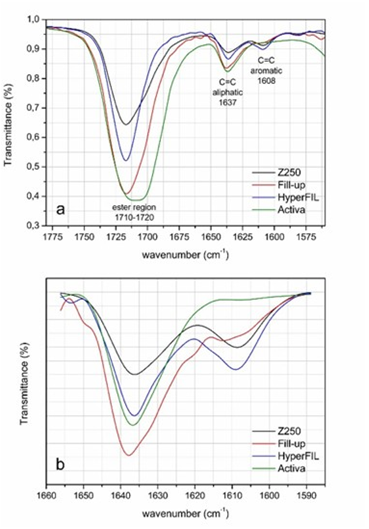
Figure 1 FTIR spectrum of uncured composites in the wavenumber range of (a) 1550-1775 cm-1 and (b) C=C double bond region.
VHN
The bottom/top VHN values of the materials are presented in Table 2. At a thickness of 6mm, Filtek Z250 showed the highest bottom/top VHN value (98.17±2.4) compared to the other groups.
The bottom/top VHN values of the 2-, 4-, and 6-mm thick ACTIVA samples thicknesses were found to be less than 80% (Table 2).
Compression test
Figure 3.a, Figure 3.b, and Figure 3.c show examples of test specimens at different thicknesses, compression testing devices, and fractured specimens, respectively. There was no statistically significant difference between the CS values of each material at different thicknesses (p>0.05). No difference was found between the materials with a 2-mm thickness. The highest CS values were observed in the Filtek Z250 group, with values of 278.4±38.4, 271.2±50.4, and 269.2±36.3 for the 2-, 4-, and 6-mm thick samples, respectively.
Figure 4.a shows representative stress- strain (SS) curves of a composite sample. The average CS values and standard deviations for each sample series at different thicknesses are listed in Table 3. In the column graph shown in Figure 4.b, the CS values of the samples are compared as a function of composite type and sample thickness. The mechanical parameters of the samples are also listed in Table 3.
Fracture surface analysis
SEM micrographs of representative composite samples imaged at magnifications of 1,500× and 5,000× are shown in Figure 5 and Figure 6, respectively. These images were taken at the fractured surfaces of the samples. Figure 7 shows fractured regions of the tested composites. As seen in Figure 5, inorganic components are distributed well into the resin matrix in all of the composites. The higher magnification images shown in Figure 6 imply that there are no holes or voids around the particles. Figure 6d indicates that the average particle size of the ACTIVA composite is larger than that of the other composites. Figure 7.a, Figure 7.b, and Figure 7.c compare fractured regions of the Filtek Z250 composite at different thicknesses, and the images taken at a lower magnification were used to determine the failure mechanism of the composites. Figure 7.d shows the fracture lines that appeared in the 6-mm thickness ACTIVA sample. Vertical and deep cracks that fragmented the specimen into several big pieces are clearly seen in this image.
Table 2 Bottom/top ratio of VHN values of the materials.
| - | Specimen Depth | - | - | - | - |
|---|---|---|---|---|---|
| - | 2mm | 4mm | 6mm | - | - |
| Material | Mean ± SEM | Mean ± SEM | Mean ± SEM | Material | Depth |
| Z250 | 97,94 ± 1,01 a, A | 95,63 ± 1,91 a, A | 98,17 ± 2,4 a, A | - | - |
| ACTIVA | 62,91 ± 4,35 c, A | 51,12 ± 4 b, AB | 43,48 ± 5,64 c, B | <0,001 | <0,001 |
| Fill-Up | 80,02 ± 5,25 b, B | 97,42 ± 5,27 a, A | 52,93 ± 5,72 c, C | - | - |
| HyperFIL | 91,43 ± 1,62 ab, A | 90,9 ± 1,93 a, A | 82,11 ± 3,97 b, A | - | - |
*a, b, c, d: Values in the same column with different superscripts represent statistical difference (p<0.05) (Two-way ANOVA, post hoc Bonferroni).
*A, B: Values in the same row with different superscripts represent statistical difference (p<0.05) (Two-way ANOVA, post hoc Bonferroni).

Figure 3 Representative photographs of (a) test specimens with a thickness of 2, 4, and 6mm, (b) compression test device, and (c) a cracked composite sample after compression test.
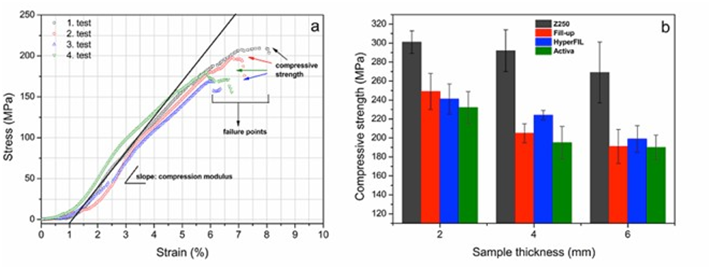
Figure 4 (a) A typical stress-strain behavior of samples obtained from compression test. The characteristic mechanical parameters of samples (i) ''elastic (or compressive) modulus,'' which is a slope of the SS curve, and (ii) ''CS,'' which is a maximum stress value before failure and ''strain at failure'' under compressive loads are defined on the SS curves. (b) Comparing the CS values of samples as a function of composite type and thickness.
Table 3 Compression strength (CS) values (MPa) of the composites.
| - | Thickness of specimen (mm) | - | - |
|---|---|---|---|
| Materials | 2 mm | 4 mm | 6 mm |
| Filtek Z250 | 278.4 ± 38.4aA | 271.2 ± 50.4aA | 269.2 ± 36.3aA |
| Fill-Up | 231.6 ± 42.6bA | 205.2 ± 10.8bB | 190.8 ± 20.7bB |
| ACTIVA | 226.4 ± 21.9cA | 185.2 ± 20.4cB | 190.2 ± 1512cB |
| HyperFIL | 230.6 ± 28.9dA | 213 ± 24.4dAB | 198.4 ± 13.7dB |
*a, b, c, d: Values in the same row with different superscripts represent statistical difference (p<0.05) (One-way ANOVA, post hoc Tukey).
*A, B: Values in the same column with different superscripts represent statistical difference (p<0.05) (One-way ANOVA, post hoc Tukey).
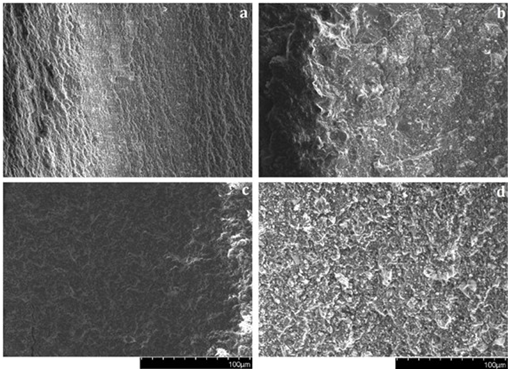
Figure 5 SEM images of composites with a magnification of x1500. (a) Filltek Z250, (b) Fill-Up, (c) HyperFIL, and (d) ACTIVA.
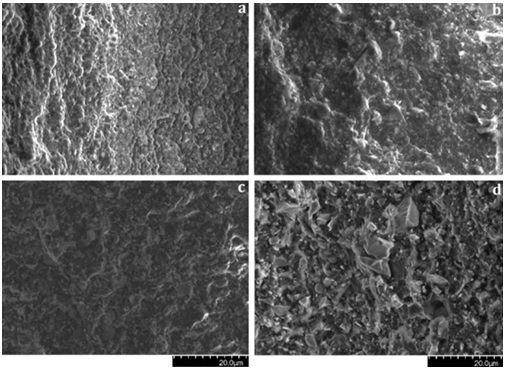
Figure 6 SEM images of composites with a magnification of x5000. (a) Filltek Z250, (b) Fill-Up, (c) HyperFIL, and (d) ACTIVA.
Discussions
The number of studies on the DC and mechanical properties of dual-cure bulk-fill composites is increasing in the literature (22,23,24). In this study, the first null hypothesis, that the DC does not significantly decrease as the increment thickness increases, was rejected. The DC of three new dual-cure bulk-fill RBCs was evaluated at three clinically relevant thicknesses. A traditional incremental composite, Filtek Z250, was also investigated for comparison. The results showed that the DC of the four composites was material-related and thickness-related.
The Filtek Z250 composite contains a mixture of bisphenol A-glycidyl methacrylate (Bis-GMA), urethane dimethacrylate (UDMA), and bisphenol A ethoxy dimethacrylate (Bis-EMA) monomers, which led to it demonstrating higher DC, VHN, and CS than the other RBCs tested in this study. The bioactive dual-cure bulk-fill composite (ACTIVA) was found to have the lowest VHN, DC, and CS values at all thicknesses. This result was expected since ACTIVA has water in its resin structure and a lower filler content than the other tested composites (25, 26).
FTIR is one of the direct methods used to determine DC, and it provides reliable and accurate results (27). Typically, the DC is determined by analyzing the ratio of the peak values that correspond to aliphatic and aromatic double bonds (28). The DC is affected by many factors, such as the light source, light exposure time, chemical structure of the composite resin, monomer content, inorganic fraction, and layer thickness (29). In the analysis of our results, it is particularly relevant to note that crosslinks in composite structures render the polymerization of resins containing dimethacrylate more complex. A DC between 20% and 80% is the point at which resins containing dimethacrylate show complete polymerization (30). In our study, all of the composite resins reached sufficient polymerization levels at the different thicknesses tested (Figure 2). The resin content of the tested samples increased in the order of ACTIVA>Fill- Up>HyperFIL>Filtek Z250. Interestingly, Hyper- FIL showed a significantly higher DC% value than Fill-Up, despite the resin content of HyperFIL (25-30 wt%) being lower than that of Fill-Up (35 wt%), according to the data sheet information listed in Table 1. This may be related to the higher reactive group content of the HyperFIL composite resin. Moreover, HyperFIL was photoactivated for 40 s, resulting in a total radiant exposure of 44 J/cm². This may have contributed to a higher DC% (31).
The second null hypothesis-that the bottom/ top VHN ratio of the tested materials does not significantly decrease as the increment thickness increases-was partially rejected. The thickness of the layers in which the composite resin must be applied is important to achieve an acceptable DC (32). When the microhardness measurement method is used, the DC of a composite resin is determined by the ratio of the bottom/top surfaces microhardness values. In the literature, a bottom/ top surface ratio of 80-90% is stated as a clinically acceptable degree of curing (33). According to our results, as the thickness increased from 2mm to 6mm, the DC%, bottom/top ratios of VHN, and CS values of all samples decreased. The bottom/ top VHN ratio of Filtek Z250 at a thickness of 6mm showed the highest value when compared to the other bulk-fill composite resins (98.17±2.4; Table 2). This may be because it was polymerized using the conventional method at the 2-mm thickness. When the Filtek Z250 composite resin content was examined, it was found that a large amount of TEGDMA had been replaced by UDMA and Bis-EMA. We think that the increased amount of UDMA monomer in the structure of the composite resin was also a factor that contributed to the high DC. The UDMA monomer shows a higher DC% than the Bis-GMA monomer due to its relatively high molecular weight, double-bond concentration, and low viscosity. The fact that the bottom/top surface VHN values of the ACTIVA samples prepared at thicknesses of 2, 4, and 6mm were less than 80% may be because ACTIVA does not contain UDMA and Bis-GMA monomers.
Sideridou et al. (34) reported that the DC of light-cured dimethacrylate-containing RBCs was affected by their chemical components, and that the DC increased in the order of Bis-GMA<Bis- EMA<UDMA<TEGDMA. However, the ratio of filler amount to resin is also important for polymerization. As the amount of filler increases, it becomes more difficult for the composite to polymerize (35). Increasing the amount of filler prevents polymeric chain propagation (36) and reduces the mobility of Bis-GMA due to its high viscosity (34). Hence, in our study, the finding that ACTIVA showed the highest DC% at thicknesses of 2 and 4mm (Figure 2) can be attributed to it containing a low amount of filler.
The third null hypothesis, that the CS of the tested materials differs significantly as the thickness increases, was also rejected. The mechanical parameters of restorative composites obtained from typical low-speed compression tests have been previously defined in detail (37) and can be found elsewhere (38,39). CS is regarded as the most important mechanical property of dental restorative materials because it directly represents the mechanical durability and long-term performance of a material under loading conditions. Poiate et al. reported the standard and maximum masticatory forces on adult posterior teeth as 100 N and 235.9 N, respectively (40). Many studies have reported on the force distribution on the occlusal points and associated stresses on posterior teeth (41,42,43). The CS and mechanical performance of a dental restorative composite depend on many parameters, such as (i) the composite composition, (ii) the interfacial interaction between the organic resin and the inorganic particles, (iii) the geometry, size, and size distribution of the inorganic particles, (iv) the curing procedure, and (v) the post- curing treatments. It is generally accepted that the composite composition (specifically the number of inorganic particles), the curing procedure (e.g., the light source's power and wavelength and the irradiation time), and other related features (e.g., the DC in the resin matrix and the shrinking ratio) greatly influence the success of a filling operation and the life of filling materials. Although no statisti- cal difference was found between the values, in our study, the CS of the composites decreased as the sample thickness increased, as expected. This was possibly due to the reduction in the DC values, as previously reported (4,37). At a thickness of 2mm, it was found that the CS decreased in the order of Filtek Z250>Fill-Up>HyperFIL>ACTIVA. The CS values of Fill-Up, ACTIVA, and HyperFIL were found to be similar at a thickness of 6 mm, whereas Filtek Z250 yielded the highest CS at this thickness. This result clearly implies that the CS was not greatly influenced by the DC when the cured composite was relatively thick. In these circumstances, it can be concluded that the most effectual parameter is the number of inorganic particles because Filtek Z250 possesses a higher inorganic content than the other composites. The CS values recorded in this study are also consistent with those repor- ted in a previous study. Khosrevani reported the CS and elastic modulus values of Filtek Z250 as 418±16 MPa and 2.14±0.15 GPa, respectively, when tested at a thickness of 4mm (44).
As shown in Figure 4, the complete failure or fracture points of the specimens fell within the strain range of 0.05-0.09. Elastic modulus values were also found to be within the range of 2-4 GPa. These values are consistent with previously reported results for various dental restorative composites (45).
In a study conducted by Leprince et al. (46), it was found that despite Venus Bulk Fill and SDR composite resins showing high DC values, their macro and micromechanical properties were lower than those of other tested composites. This lack of positive correlation between DC and mechanical properties was explained by the fact that all the tested materials contained different monomer structures. Our finding that ACTIVA demonstrated a higher DC% than Filtek Z250 aligns with the results of Leprince et al. (46).
The images shown in Figure 6 prove that the interfacial adhesion between the resin and the particles was strong in each of the tested samples. ACTIVA probably includes particles with a broader size distribution. One can easily note that the rough fracturing tracks shift to smoother, vertically aligned tracks with an increase in thickness. This was probably due to the decrease in the DC% with increasing thickness and the occurrence of fracturing throughout the resin phase (4). It may be concluded that the resin phase, which has much lower stiffness than the inorganic particles, is mainly responsible for the fracturing of thick composites, based on the similarities observed between Figure 7.c and Figure 7.d.
Dual-cure bulk-fill RBCs are new to the market, and further studies are needed to determine their long-term clinical performance. Additional research is needed to validate the results of our study, especially studies with different dual- cure bulk-fill composite materials.
Conclusions
Taking into account the limitations imposed on this in vitro experiment, the following conclusions may be reached:
The depth-associated decrease in the DC% of the tested materials was found to be material-dependent.
The bottom/top VHN ratio of the conventional layered composite was not significantly different at all thicknesses; however, as the thickness increased, the hardness of the dual-cure bulk-fill composite resins was significantly lower than that of the conventional composite.
When tested at greater thicknesses, the CS of the dual-cure bulk-fill composite resins was lower than that of the conventional composite resin.
Author contribution statement
Conceptualization and design: A.S.G, N.D. and A.D.
Literature review: A.S.G and A.D.
Methodology and validation: A.S.G., B.Z.K., A.D. and S.S.K.
Formal analysis: A.S.G. and A.D.
Investigation and data collection: A.S.G., B.Z.K., A.D. and S.S.K.
Resources: A.S.G. and A.D.
Data analysis and interpretation: A.S.G., B.Z.K., A.D. and S.S.K.
Writing-original draft preparation: A.S.G. and A.D.
Writing-review & editing: A.S.G., A.D. and N.D.
Supervision: N.D.
Project administration: A.S.G., A.D. and N.D.
Funding acquisition: A.S.G., A.D. and N.D.














